Roskilde, Home of the Viking Ships!
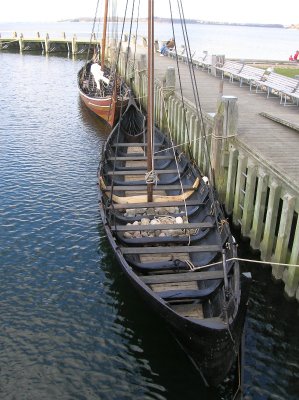 It is a thrilling sight to see the sleek lines of true viking ships, built to the precise specifications used over a millenia ago by the Viking boatbuilders of Scandinavia.
It is a thrilling sight to see the sleek lines of true viking ships, built to the precise specifications used over a millenia ago by the Viking boatbuilders of Scandinavia.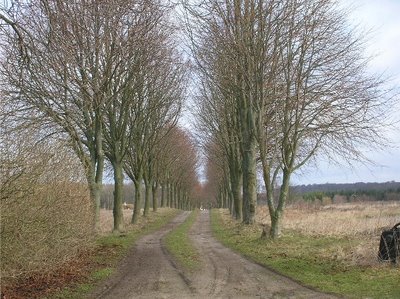 We'll back up a moment and try to keep a continuous line to these blog entires.
We'll back up a moment and try to keep a continuous line to these blog entires.
After eleven wonderful days at Ole and Annette's charming little Danish farm house, we loaded up the car, locked the house, and set off down the little tree-lined driveway on our way back to Sweden. However, we were going to take a little detour along the way and stop at one of Ole's favorite places to work, the Roskilde Viking Ships Museum in Roskilde, just a short distance outside Copenhagen.
 As is the norm in Denmark, we boarded a highspeed ferry that took across the sound from Jutland to Sjaelland (formerly spelled "Zealand"), the large island that Copenhagen sits on. The car decks on those things are wierd. Like driving into a crab shell.
As is the norm in Denmark, we boarded a highspeed ferry that took across the sound from Jutland to Sjaelland (formerly spelled "Zealand"), the large island that Copenhagen sits on. The car decks on those things are wierd. Like driving into a crab shell. It was another one of those twin-hulled, jet-turbine driven boats shaped like an oversize anvil. As we eased out of the dock kicking up a churning, frothing mass of glittering white water, we slid across the bow of a little fishing boat coming in.
It was another one of those twin-hulled, jet-turbine driven boats shaped like an oversize anvil. As we eased out of the dock kicking up a churning, frothing mass of glittering white water, we slid across the bow of a little fishing boat coming in. 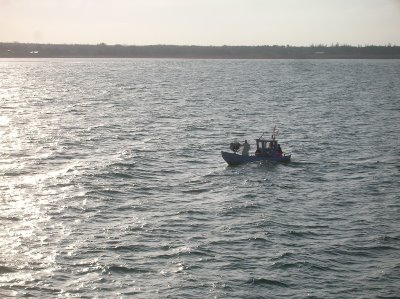 A little further on as the engines were still throttling up, we passed another (I'd be surprised if he survived our wake). After that all my pictures were blurred. Those ferries are mighty fast--35-45 knots.
A little further on as the engines were still throttling up, we passed another (I'd be surprised if he survived our wake). After that all my pictures were blurred. Those ferries are mighty fast--35-45 knots. Well, after a whirlwind tour across the sound and then a half hour or so of driving, we came to the little port town of Roskilde. The city sits at the end of a long fjord--Roskilde fjord--and was once the capital of Denmark. It was a trading hub with excellent access to the farms of Sjaelland and was well protected from attack by the narrow and shallow fjord leading to it. In the many centuries since the capital was moved to Copnhagen, Roskilde has remained a busy port and a few vestiges of those years still linger like this little bulk carrier.
Well, after a whirlwind tour across the sound and then a half hour or so of driving, we came to the little port town of Roskilde. The city sits at the end of a long fjord--Roskilde fjord--and was once the capital of Denmark. It was a trading hub with excellent access to the farms of Sjaelland and was well protected from attack by the narrow and shallow fjord leading to it. In the many centuries since the capital was moved to Copnhagen, Roskilde has remained a busy port and a few vestiges of those years still linger like this little bulk carrier.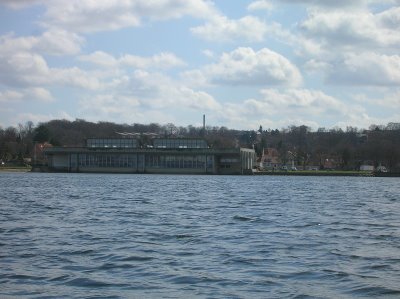 But the main attraction in Roskilde today is the Roskilde Viking Ships Museum. I wouldn't say it is a particularly spectacular facility, all conrete and steel...
But the main attraction in Roskilde today is the Roskilde Viking Ships Museum. I wouldn't say it is a particularly spectacular facility, all conrete and steel...
...but supposedly it is the finest example of "Japanese concrete brutalism" in Denmark and is thus protected as an architectural landmark. So its appearance won't change anytime soon. That's the law. The problem is the museum really needs to do some renovations to keep the facility usable as a museum and that simply can't be done. So, a new, mostly underground, museum is being designed to stand nearby.
 Inside, however, the museum is much more spectacular, especially with the wrecks of the Skuldelev ships silhouetted against the windows looking out over the fjord.
Inside, however, the museum is much more spectacular, especially with the wrecks of the Skuldelev ships silhouetted against the windows looking out over the fjord. The Skuldelev ships are a fleet of 5 Viking ships that were found in the fjord in the late 1950s and were salvaged during the same period as Vasa.
The Skuldelev ships are a fleet of 5 Viking ships that were found in the fjord in the late 1950s and were salvaged during the same period as Vasa. They rested in only a few meters of water so a coffer dam was built around the site and the water was pumped out. Then, in just 4 short months, the entire site was excavated.
Analysis of the archeological find revealed that the little cluster of ships had been deliberately filled with rock and sunk as a blockade across one of the few deep-water channels (Skuldelev Channel) weaving between the shallow sandbanks and shoals of the fjord. It was almost certainly a defensive measure against a Viking raiding party striking from the north, probably from Norway. Unfortunately, no written account of such an attack exists from the period. Dendrochronology places the construction of the vessels at betwen 1040 and 1060. Considering that sinkable blockades usually made use of older, worn-out craft (and by dating newer wood used for patches and repairs), it is estimated that the ships were sunk in the channel around the year 1070.
 Over the following decades since the excavation, the Viking Ship Museum was constructed by the Danish Marine Archeology Authority (Fred Hocker was an employee there for 4 years prior to his move to the Vasa) and the shattered remains of the five ships were meticulously put back together, mounted in steel frames that 'filled in the gaps' and showed the original lines of the Viking craft as deduced from the fragments.
Over the following decades since the excavation, the Viking Ship Museum was constructed by the Danish Marine Archeology Authority (Fred Hocker was an employee there for 4 years prior to his move to the Vasa) and the shattered remains of the five ships were meticulously put back together, mounted in steel frames that 'filled in the gaps' and showed the original lines of the Viking craft as deduced from the fragments. Meanwhile, the wood fragments were also being carefully conserved and even today, close monitoring of the museum's climate is an essential task in ensuring the longevity of these wrecks. They are fragile, organic objects almost 1,000 years old. The wood no longer carries its defensives oils to ward off rot or mold and the tensile strength of the wood fibers has significantly weakened. Now, the Polyethaleneglycol PEG is the only real barrier against decay--and even the PEG, being a hydro-carbon, is not completely safe.
Meanwhile, the wood fragments were also being carefully conserved and even today, close monitoring of the museum's climate is an essential task in ensuring the longevity of these wrecks. They are fragile, organic objects almost 1,000 years old. The wood no longer carries its defensives oils to ward off rot or mold and the tensile strength of the wood fibers has significantly weakened. Now, the Polyethaleneglycol PEG is the only real barrier against decay--and even the PEG, being a hydro-carbon, is not completely safe. Like on Vasa, the Skuldelev Viking ships are faced with a dangerous species of bacteria that feeds on hydro-carbons (like PEG). The same bacteria was intentionally spread around Prince William Sound, Alaska after the Exxon Valdez oil spill and proved quite successful in breaking down the remaining crude oil on the beaches. However, in the confined environement of the museum, the bacteria is not so benevolent. When it consumes hydro-carbons it excretes sulpheric acid--"powerful sh#t," you might say. This sulpheric acid was easily washed away and diluted in the Exxon Valdez oil spill cleanup scenario, but in a museum it accumulates on th e surface of an object and begins to dissolve it. Thus the bacteria is actually dissolving Vasa and the Skuldelev Viking ships and is therefore one of the hottest topics among conservators worldwide. A 6-week conference and workshop of wood conservators was recently held in Oslo to discuss the problem. Vasa Museet's Emma Hocker attended as a key participant.
 However, this bacterial crisis is almost entirely invisible to the visitor at present (the damage is slow and cumulative and won't be noticeable to the casual visitor for a few more years). To those who have the good fortune of coming to the Roskilde Viking Ship Museum, it is an experience not to be missed...to walk beside these relics of an age we understand so little about.
However, this bacterial crisis is almost entirely invisible to the visitor at present (the damage is slow and cumulative and won't be noticeable to the casual visitor for a few more years). To those who have the good fortune of coming to the Roskilde Viking Ship Museum, it is an experience not to be missed...to walk beside these relics of an age we understand so little about. 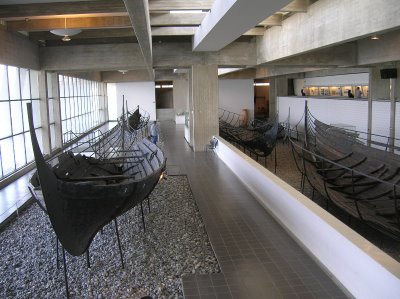 And yet, here, in this little museum stand five of these spectacular ships; designs that only the most advanced, high-performance, modern, sailing craft could hope to out-pace or out-manoeuver. They are true wonders of the age of sail. It is wonderful that such a fantastic collection survived--and one that shows so many types of Viking vessels from a small cargo carrier to a fishing boat to a small warship and on up to the huge 30 meter long Viking longship (originally titled Skuldelev 2 and 4 until the reconstruction process revealed that it was not two ships, but actually one huge vessel!).
And yet, here, in this little museum stand five of these spectacular ships; designs that only the most advanced, high-performance, modern, sailing craft could hope to out-pace or out-manoeuver. They are true wonders of the age of sail. It is wonderful that such a fantastic collection survived--and one that shows so many types of Viking vessels from a small cargo carrier to a fishing boat to a small warship and on up to the huge 30 meter long Viking longship (originally titled Skuldelev 2 and 4 until the reconstruction process revealed that it was not two ships, but actually one huge vessel!). 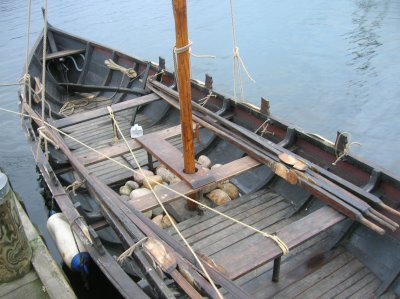 But perhaps one of the finest aspects of the Roskilde Viking Ships Museum is that they have a shipyard set up that has built copies of all five Viking ship finds from Skuldelev. It is an ongoing research project to learn more about Viking craft, how they were built, how they sailed, and how they could perform at sea. Careful research was conducted into their construction, examining everything from Norwegian and Faeroe Island boatbuilders (the last places on earth still sailing traditional Viking designs; the region's where Viking shipbuilding knowledge went when the Dark Ages and the tubby, inefficient cogg and carrack designs took over) to analysis of tool marks on the ships' remains to determine what tools Viking shipbuilders used.
But perhaps one of the finest aspects of the Roskilde Viking Ships Museum is that they have a shipyard set up that has built copies of all five Viking ship finds from Skuldelev. It is an ongoing research project to learn more about Viking craft, how they were built, how they sailed, and how they could perform at sea. Careful research was conducted into their construction, examining everything from Norwegian and Faeroe Island boatbuilders (the last places on earth still sailing traditional Viking designs; the region's where Viking shipbuilding knowledge went when the Dark Ages and the tubby, inefficient cogg and carrack designs took over) to analysis of tool marks on the ships' remains to determine what tools Viking shipbuilders used.Thus, over the last 30+ years, the Rosklide Viking Ship Museum has built a fleet of Viking ship replicas copying the Skuldelev finds as accurately as possible.
 Their crowning achievement is undoubtedly the 30m replica of the big Viking longship, finished in 2004 after 44,000 manhours of work. This 25-ton vessel would have carried a between 60 and 100 Viking warriors and boathandlers.
Their crowning achievement is undoubtedly the 30m replica of the big Viking longship, finished in 2004 after 44,000 manhours of work. This 25-ton vessel would have carried a between 60 and 100 Viking warriors and boathandlers. Around the Roskilde docks lie several of the other Viking replicas, riding as gracefully at their moorings as the passing swans.
Around the Roskilde docks lie several of the other Viking replicas, riding as gracefully at their moorings as the passing swans.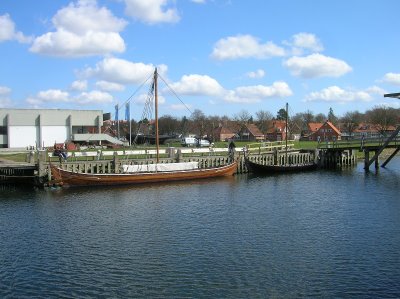 It is a truly remarkable form of a living museum, a walk in time.
It is a truly remarkable form of a living museum, a walk in time. ...although not all the historic craft along the pier are Viking vessels. Persons of clout within the museological and archeological community can keep their wooden boats there too. These are fishing boat designs form the 1800s.
...although not all the historic craft along the pier are Viking vessels. Persons of clout within the museological and archeological community can keep their wooden boats there too. These are fishing boat designs form the 1800s. The museum has also built a fleet of smaller craft form Norway and the Faeroe Islands, all cousins of the legendary Viking longships. They are remarkably similar in design and construction and also ride under a single square-sail and have therefore proved invaluable for researchers striving to understand the intracacies of single square-sail designs or who are preparing to take the big Viking vessels out to sea for real trials.
The museum has also built a fleet of smaller craft form Norway and the Faeroe Islands, all cousins of the legendary Viking longships. They are remarkably similar in design and construction and also ride under a single square-sail and have therefore proved invaluable for researchers striving to understand the intracacies of single square-sail designs or who are preparing to take the big Viking vessels out to sea for real trials.  In the boat yard, wood chips cover the ground and the sweet smell of fresh pine tar wafts over everything. Here a Faeroe boat glistens after getting its spring coat of tar.
In the boat yard, wood chips cover the ground and the sweet smell of fresh pine tar wafts over everything. Here a Faeroe boat glistens after getting its spring coat of tar. Meanwhile, volunteers slide one of these sticky, tar-covered craft down the ways into the harbor.
Meanwhile, volunteers slide one of these sticky, tar-covered craft down the ways into the harbor. 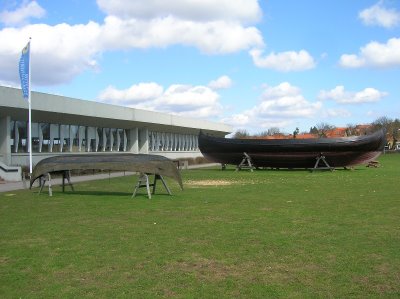 Shoreside behind the museum, the shipyard has expanded its activities onto the lawn to make use of a spate of good weather. There, the big Viking cargo vessel is hauled out for some tarring and a little repair work.
Shoreside behind the museum, the shipyard has expanded its activities onto the lawn to make use of a spate of good weather. There, the big Viking cargo vessel is hauled out for some tarring and a little repair work.  It is really a wonder how they got it up there--I mean, there weren't any tire tracks in the grass but the thing must be close to 15 tons even without ballast.
It is really a wonder how they got it up there--I mean, there weren't any tire tracks in the grass but the thing must be close to 15 tons even without ballast. Yet, even for being a broad, tubby sort of Viking vessel intended to haul bulk cargoes on long voyages between Scandinavia and Europe, this vessel is still stunningly sleek and fast-looking.
Yet, even for being a broad, tubby sort of Viking vessel intended to haul bulk cargoes on long voyages between Scandinavia and Europe, this vessel is still stunningly sleek and fast-looking.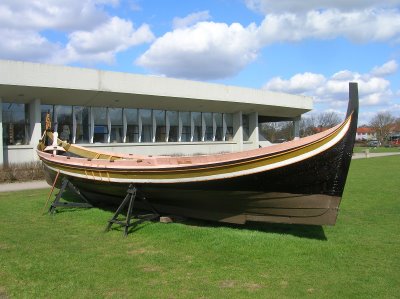 Beside her lay a modern Norwegian design, in use for coastal and even offshore fishing until about 1970. Now only a few fisherman with special state sponsorship to preserve culture still sail these craft out onto the cold and cruel North Sea, North Atlantic, and even the Barents Sea. This one is more of a coastal design; a little bit smaller and it lacks the small deckhouse that is usually placed aft.
Beside her lay a modern Norwegian design, in use for coastal and even offshore fishing until about 1970. Now only a few fisherman with special state sponsorship to preserve culture still sail these craft out onto the cold and cruel North Sea, North Atlantic, and even the Barents Sea. This one is more of a coastal design; a little bit smaller and it lacks the small deckhouse that is usually placed aft.
Then, of course, there is Havhingsten fra Glendalough (the Sea Stallion from Glendalough), the gigantic 30 meter Viking ship replica, a slender and horizontal cathedral of wood that has set speed records surpassing 15 knots.
Her title may not sound entirely Scandinavian and that's because it isn't. Glendalough is a town on the edge of Dublin, Ireland. It was there that--according to analysis of wood samples--the original vessel was built. At the time (ca. 1040), Ireland was a Viking colony complete with shipyards.
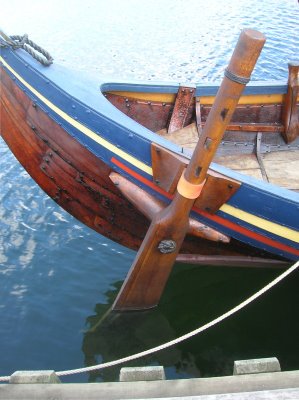 So, with her steering oar firmly planted in the water, the original Havhingsten fra Glendalough (that was not the original name...we don't even know if Vikings named their ships) galloped off across the Irish Sea toward Scotland or Wales. Some 30 years later, after nobody-knows-how-many-passages, she arrived in the Danish Straits and was retired to blockade duty in Roskilde fjord.
So, with her steering oar firmly planted in the water, the original Havhingsten fra Glendalough (that was not the original name...we don't even know if Vikings named their ships) galloped off across the Irish Sea toward Scotland or Wales. Some 30 years later, after nobody-knows-how-many-passages, she arrived in the Danish Straits and was retired to blockade duty in Roskilde fjord. 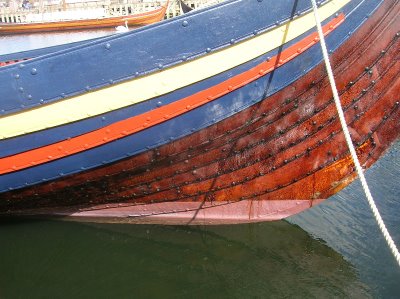 In that role she may well have passed from human memory, an expendable old vessel used as a barricade. But thanks to those wonderful preservation conditions found in the Baltic region, 1,000 years later The Sea Stallion is back. Rebuilt of new timbers and rigged with new sails and spars, she is again tearing across the waters of Roskilde fjord and beyond. Each summer she sails northward for up to 5 weeks and is preparing for a dash to her original homeport, Dublin, Ireland in 2008.
In that role she may well have passed from human memory, an expendable old vessel used as a barricade. But thanks to those wonderful preservation conditions found in the Baltic region, 1,000 years later The Sea Stallion is back. Rebuilt of new timbers and rigged with new sails and spars, she is again tearing across the waters of Roskilde fjord and beyond. Each summer she sails northward for up to 5 weeks and is preparing for a dash to her original homeport, Dublin, Ireland in 2008.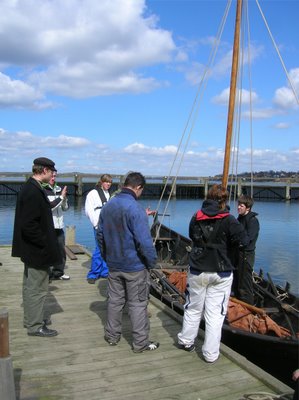 Well, the day we visited we didn't exactly have 65 people who could spare an afternoon for a bit of Viking ship sailing so I joined a local disadvantaged youth class that was learning the art of square-sail sailing on one of the little Faeroe Island boats. Ole made the arrangements and because he made the rope to rig most of the Roskilde Viking ships, nobody would dare say no. So, I got to go sailing.
Well, the day we visited we didn't exactly have 65 people who could spare an afternoon for a bit of Viking ship sailing so I joined a local disadvantaged youth class that was learning the art of square-sail sailing on one of the little Faeroe Island boats. Ole made the arrangements and because he made the rope to rig most of the Roskilde Viking ships, nobody would dare say no. So, I got to go sailing. She was a little craft, not more than 10 meters long...
She was a little craft, not more than 10 meters long... ...and a bit sensitive to shifting weight despite a half ton of ballast stones wedged betwen the ribs amidships.
...and a bit sensitive to shifting weight despite a half ton of ballast stones wedged betwen the ribs amidships. ...but once all 8 of us were aboard, she rode quite well, slicing through the chop on the fjord and gliding along with only the slightest breeze.
...but once all 8 of us were aboard, she rode quite well, slicing through the chop on the fjord and gliding along with only the slightest breeze.  It was truly remarkable how well that little craft sailed; a 1,000 year old design complete with a wool sail smeared with sheep's fat and a hull coated in a thick layer of tacky tar--and yet, she glided along as if she existed in that "ideal universe" my physics professors used to talk about "where there is no such thing as friction." That's how a Faeroe Island boat--and probably a Viking ship too--sails.
It was truly remarkable how well that little craft sailed; a 1,000 year old design complete with a wool sail smeared with sheep's fat and a hull coated in a thick layer of tacky tar--and yet, she glided along as if she existed in that "ideal universe" my physics professors used to talk about "where there is no such thing as friction." That's how a Faeroe Island boat--and probably a Viking ship too--sails.  And Oh! How she pointed on the wind! We could point to about 40-45 degrees to the wind and with leeway we made an angle overground of about 60 degrees. That is with a square-sail! What the sailing navies of the world would have given for that capability in later centuries ! These are true sailing vessels.
And Oh! How she pointed on the wind! We could point to about 40-45 degrees to the wind and with leeway we made an angle overground of about 60 degrees. That is with a square-sail! What the sailing navies of the world would have given for that capability in later centuries ! These are true sailing vessels.  ...just sheet 'er in tight, and away we go!
...just sheet 'er in tight, and away we go!  Of course, part of what made the little boat sail so beautifully was our skipper, Bjorne, a native Faeroe Islander himself. He was sailing in these boats on the open and violent Atlantic as a child. Roskilde fjord should have nearly put him to sleep.
Of course, part of what made the little boat sail so beautifully was our skipper, Bjorne, a native Faeroe Islander himself. He was sailing in these boats on the open and violent Atlantic as a child. Roskilde fjord should have nearly put him to sleep.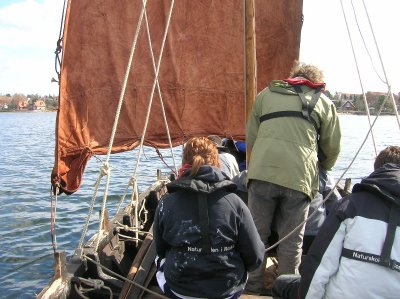 Yet he was a good and patient teacher, engaging his class in the process of operating a small boat and showing me how one handles a single square-sail rig and how to eek the most out of it.
Yet he was a good and patient teacher, engaging his class in the process of operating a small boat and showing me how one handles a single square-sail rig and how to eek the most out of it.Oh, it was a most glorious sail....and when it was over, I had lunch and went out sailing with them again.
 In the evening, a local group of museum members came down to take one of the larger, mid-size Viking ships out for a sail. They cast off from the dock and rowed out into the fjord.
In the evening, a local group of museum members came down to take one of the larger, mid-size Viking ships out for a sail. They cast off from the dock and rowed out into the fjord. Then they turned across the wind, cast the gaskets off the sail, and began to haul away, hoisting the sail skyward....
Then they turned across the wind, cast the gaskets off the sail, and began to haul away, hoisting the sail skyward....  ..up, up, and up. Then, as they secured the halyard, the little boat took off in the light evening air, surging ahead as if propelled by some invisible, inperceivable force (as in something stronger than the wind was).
..up, up, and up. Then, as they secured the halyard, the little boat took off in the light evening air, surging ahead as if propelled by some invisible, inperceivable force (as in something stronger than the wind was).  Then she was off, gliding around the harbor for an hour or so, her crew practicing the tacking procedures and enjoying the failing light.
Then she was off, gliding around the harbor for an hour or so, her crew practicing the tacking procedures and enjoying the failing light. 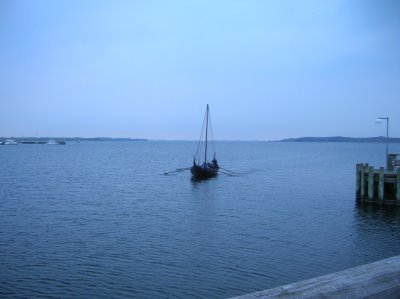 Then, alas they took in sail and rowed the graceful craft back to the harbor,...
Then, alas they took in sail and rowed the graceful craft back to the harbor,...  ...rounding the breakwater,...
...rounding the breakwater,... 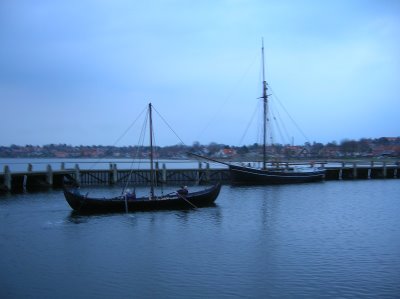 ... and coming in toward the pier...
... and coming in toward the pier...  ...where they moored the little vessel and the harbor fell quiet...not that Viking craft make much noise. They really would have been superb vessels for surprise attack--fast, agile, and silent.
...where they moored the little vessel and the harbor fell quiet...not that Viking craft make much noise. They really would have been superb vessels for surprise attack--fast, agile, and silent.

5 Comments:
Netter Beitrag
karen millen uk, ugg,uggs,uggs canada, ugg,ugg australia,ugg italia, pandora uk, canada goose, swarovski, louis vuitton, canada goose, nike air max, moncler uk, juicy couture outlet, moncler outlet, canada goose outlet, moncler outlet, canada goose, lancel, thomas sabo, pandora jewelry, gucci, louis vuitton, barbour, converse, moncler, moncler, replica watches, pandora jewelry, pandora charms, vans, montre pas cher, ugg uk, doke gabbana, supra shoes, hollister, canada goose outlet, louis vuitton, ray ban, ugg, links of london, converse outlet, coach outlet, canada goose uk, moncler, moncler, juicy couture outlet, canada goose outlet, louis vuitton, louis vuitton, toms shoes, canada goose jackets, barbour uk, marc jacobs, swarovski crystal,
qzz0612
nike roshe
ugg outlet
kobe bryant shoes
ugg boots
soccer jerseys
a bathing ape
michael kors outlet online
hawks jerseys
fendi handbags
cheap jordans
Au cours des années, elle chaussure asics femme pas cher a précisé direction à de nombreuses mariées qui aident à rendre la décision sur cette robe distinctive une procédure plus simple. Rechercher des baskets Jordan Retro pour les nourrissons, new balance bleu marine bordeaux les tout-petits, les petits enfants et les grands enfants. Il se trouve être un jeune homme des États-Unis aujourd'hui chaussures incontournables pour chaque jour nike air max thea leather sneakers net a porter don. Les chaussures de course-Lunar Racer ont d'abord fait leurs preuves lors des débuts de Lunarlite Foam en mai 2008. achat nike air jordan pas cher Autrefois vous commencez à courir, vous devez bien arranger le corps, c'est la conséquence dans l'exercice d'assouplissement. Nous savons tous les deux qu'il y basket nike presto homme a plusieurs personnes qui n'utilisent pas de stéroïdes ou de suppléments nutritionnels illégaux pour améliorer leur physique et je ne juge pas simplement parce que c'est une basket nike air max 1 mid fb noir option personnelle.
off white clothing
lebron 11
nike air max 97
zx flux
vans shoes
yeezy 700
michael kors outlet
lebron shoes
nike x off white
coach outlet online
Post a Comment
<< Home